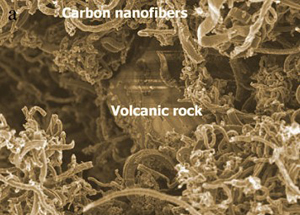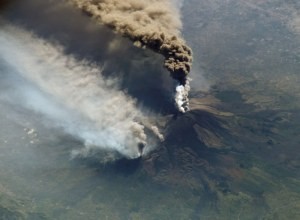Nanotubes made using volcanic lava as a support and catalyst come of age with a new paper to be published in the journal Advanced Materials, highlighting applications in the area of heterogeneous catalysis with industrial potential.
Dang Sheng Su and his colleagues at the Fritz Haber Institute in Berlin, Germany, and the Rudjer Boskovic Institute in Zagreb, Croatia, turned to igneous rock formed during eruptions of Mount Etna in Sicily to help them mass produce carbon nanotubes.

Volcanic rock can be used to create nanoscopic carbon fibres and nanotubes for industrial catalyst use (Credit: Su et al/Adv Mater)
Carbon nanotubes and nanofibres have become almost indispensable to components of the emerging fields of nanoscience and nanotechnology. Unfortunately, making CNTs in large quantities has remained an obstacle to the widespread adoption of these materials in research and applications. Su and colleagues recently discovered that they could use highly-porous particles of iron oxide from Etna’s residual igneous rocks as a templating system for depositing CNTs and related carbon nanofibres directly.
Previously, the team developed a unique method of making their catalyst. To prepare the volcanic material, the team first pulverizes the igneous rock and heats it to 700 Celsius under an atmosphere of hydrogen gas. This chemically reduces the iron oxide nanoparticles. They next expose the particles to an organic, carbon-containing, gas – ethylene – together with a hydrogen carrier. Carbon atoms from the ethylene are released through CVD, chemical vapour deposition, and condense on the surfaces of the tiny iron oxide particles, much as dew condenses on blades of grass on a cold morning. The result is the formation of tiny fibres and hollow tubes of pure carbon.

Mount Etna’s periodic eruptions could revolutionise nanoscience
The main advantage of this volcanic approach to nanotubes lies in the all-too renewable nature of the template material. Moreover, there are no wet chemical reactions to carry out and the scheme works at relatively moderate temperatures. We have proven the concept of using this useless natural material, lava, for nanocarbon growth, Su told Spotlight.
The team has now shown that they can obtain high yields of CNTs without amorphous carbon impurities. This is an important step to reduce the high cost of CNT synthesis, Su adds. The team used scanning electron microscopy (SEM) to study in minute detail the structure of their carbon products.
The next step was to develop applications for the products. The systems seem to be well suited for the desired purpose of using them as carbon hybrid catalysts to compete with industrially optimized catalytic systems. We have now found that the materials can be used as a catalyst for the production of the important industrial chemical styrene through the oxidative dehydrogenation of ethyl benzene, explains Su, The synthesis is highly selective and the carbon catalyst is stable during the reaction. In addition, the system is also active and stable for synthesis of butadiene from 1-butene by oxidative dehydrogenation.
Su suggests that the realization of volcanic CNT catalysts could provide a highly economical way to produce other important starting materials in the chemical industry. Further challenges could be use other waste or otherwise ‘useless’ natural materials for chemistry, catalysis and nanotechnology, he says.
Further reading
Angew. Chem., 2007, 46, 1823-1824
http://dx.doi.org/10.1002/anie.200604207
Professor Dr Robert Schlögl
http://w3.rz-berlin.mpg.de/ac/em/index.html
Adv. Mater., 2008, published online Aug 27, 2008
http://dx.doi.org/10.1002/adma.200800323
Suggested searches
carbon nanotubes
igneous rocks
scanning electron microscopy
catalysis